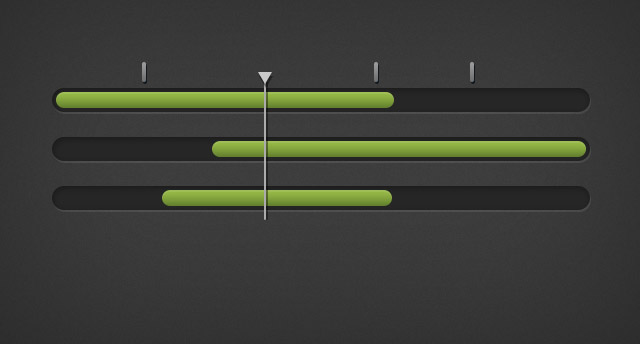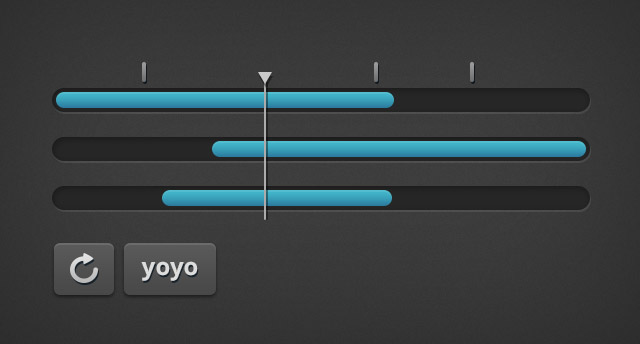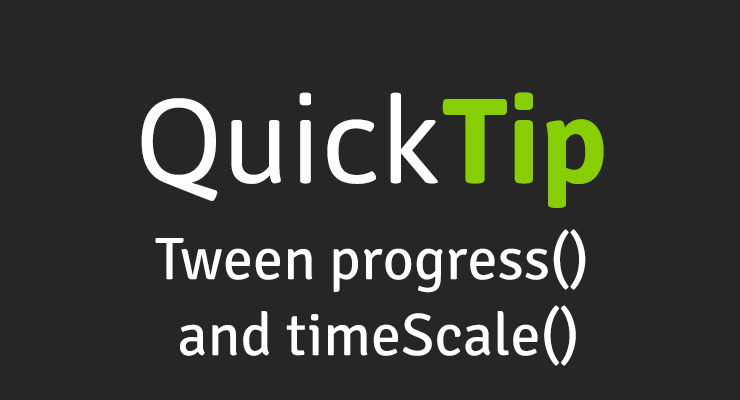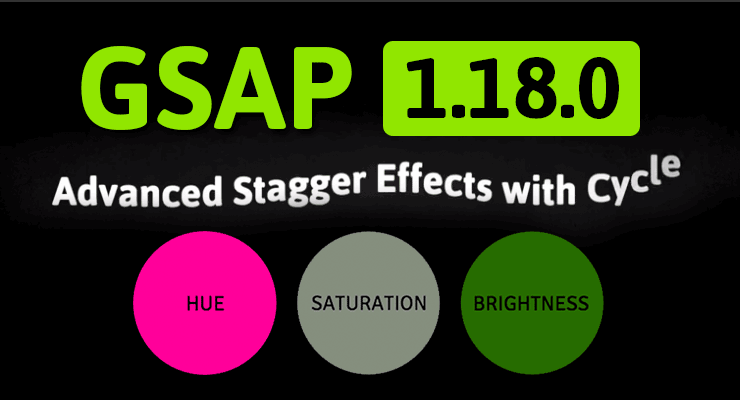Search the Community
Showing results for tags 'tween'.
-
Hey! I recently switched from Tween.JS to GSAP, and I'm trying to tween a number with potentially large number of decimal places. I wrote a small library that finds-on-screen and auto-tweens those numbers, so I do not have a *predefined* number of decimals - but as they're cryptocurrency prices, those can be 4, 6, 8 or 9 - usually. I noticed that both TweenMax and TweenLite do only 4 decimals, which is quite weird. Looking around the web (and this forum) I cannot find a solution/parameter/switch how to alter this behavior. Any advice? import gsap from 'gsap'; import { TweenLite, Expo } from 'gsap/all'; gsap.registerPlugin(Expo); export default class TweenEmAll { // ..cut objTween = undefined; objTweenProgress = { value: 0.000001 }; // experiment with pre-defined 6 decimals // ..cut tween() { // ..cut // launch new tween this.objTween = TweenLite.to(this.objTweenProgress, this.duration, { value: this.target, ease: Expo.easeOut, //decimals: 6, // experiment //autoRound: false, // experiment onUpdate: this.onTweenUpdate.bind(this) }); } onTweenUpdate() { // reconstruct value nicely let value = this.objTweenProgress.value.toFixed(6); // experiment // update appropriate element if(this.isInput) this.elmContainer.val(value); else this.elmContainer.html(value); } }
-
Fire complete animation at once within ScrollTrigger with scrub
nevanthegreat posted a topic in GSAP
Hello Club Green Sock! I was reading about the common Scroll Trigger mistakes looking for a solution to this question. I think may be going about this the wrong way, but... I have a timeline let hardwareTimeLine = gsap.timeline({ scrollTrigger: { trigger: ".centering-container", scrub: true, pin: true, pinSpacing: true, start: "top", end: "150%" } }); hardwareTimeLine .from(".hero-header", {}) .fromTo(".animated-header", {autoAlpha: 1, top: "29%"}, {autoAlpha: 0, top: "27%"}) .fromTo(".scaling-container", {duration: 1, scaleX: 1.6, scaleY: 1.6, transformOrigin: "50% 50% 0", backgroundPosition: "center"}, {duration: 1, scaleX: .6, scaleY: .6, transformOrigin: "50% 50% 0", backgroundPosition: "center"}, "<") .fromTo(".screen-inner-1", {duration: .5, transform: "translateX(0)"}, {duration: .5, transform: "translateX(-103%)"}) .fromTo(".screen-inner-2", {duration: .5, transform: "translateX(103%)"}, {duration: .5, transform: "translateX(0)"}, "<") .from(".icons-tray", {y: 150, autoAlpha: 0}); and I was wondering if there was a way to put a tween inside the timeline that is attached to the Scroll Trigger at the very end of my last ".from", if that makes sense? I tried .tweenTo() but that didn't seem to give the effect I am searching for. For example (see my codepen, you may need to look it at on full screen) I would like the grey box (".icons-tray") to tween up on it's own and only be started by the scroll trigger. Can anyone point me in the right direction of the way to approach this effect or have a working demo that shows this? Thank you so much!!! -
Hey Club Greensock! I was just wondering if I could get some assistance on my project. I have a pretty good base (I think). I just had a couple questions and was wondering if someone might be able to give me some ideas and direction. In my pinned timeline, I have a container that I scale down. I am wondering how might one go about how to decrease the pin spacing as this timeline progresses? As you can see in the image, there is a huge gap due to the scale down. Is there a way to adjust the pinspacing so the final resting place of the animation obeys the global defaults I have setup for the section container? If that makes sense? Specifically if you look at my pen on chrome, there is a weird thing it's doing where there's like a slight margin that is revealing the background slide as it moves. It doesn't do this on FF. Tell me if there is a better way to do this, but basically I have the laptop as a png, the screen area is the transparency, and I have a white bg on the sides of the screen image (to hide the slides) and then I did an overflow: hidden on that laptop png. I know there's got to be a better, more flexible way of doing this. Any suggestions? I would like to setup a global tween (".reveal-up") that I can apply to be flexible to many elements on the page (sort of how like green sock does it here). I have it setup on the header and text in the section with the boxes that rotate and "fly-in". It plays, but it doesn't play when in view, rather it plays at the top of the page. How can I approach this to be more flexible so it plays when in view and also be able to apply it to other elements? Tweening inside my scroll trigger timeline. Specifically I am talking about the text "Lorem Ipsum" that is layerd above the laptop. I know how to make it part of the scroll, but is there a way to trigger it on scroll, but not to play with the scroll? If that makes sense. How would one go about triggering it on scroll, but to play through regardless of the users inputs on the scroll and additionally to reset? I am not sure if this is a thing, but when the browser resizes, there's some funkiness that happens to the timelines. Is there a way that I can make it more flexible on browser resize so the funkiness doesn't happen? Thank you for any help. Here's a couple images to assist in my questions:
- 8 replies
-
- pin spacing
- timeline
-
(and 1 more)
Tagged with:
-
Note: TweenMax has been deprecated in GSAP 3 in favor of the streamlined gsap object. It has 50+ new features and is almost <strong>half the size!</strong> GSAP 3 is backward compatible with the vast majority of GSAP 2 features including TweenMax. Please see the Migration Guide for details. TweenMax lets you animate literally any property of any object that JavaScript can touch (CSS, SVG, React, Vue, Three.js, canvas, motion paths, generic objects, etc.). Before the release of GSAP 3, TweenMax was the most feature-packed (and popular) animation tool in the GSAP arsenal. However in GSAP 3, you no longer even need to reference TweenMax in your code (although you can because GSAP 3 honors the vast majority of legacy code). We strongly recommend migrating to GSAP 3's streamlined syntax. Quick links Getting started What's so special about GSAP? Documentation: Version 2 | Version 3 Showcase (examples) For convenience and loading efficiency, TweenMax version 2 and earlier included TweenLite, TimelineLite, TimelineMax, CSSPlugin, AttrPlugin, RoundPropsPlugin, BezierPlugin, and EasePack (all in one file). Every bit of that functionality (plus a lot more) is in the GSAP 3 core which is almost half the size. Staggered animations GSAP makes it easy to create staggered animations on multiple objects. The animations can overlap, run in direct sequence or have gaps between their start times. The old TweenMax stagger methods (from version 1 and 2): TweenMax.staggerTo(), TweenMax.staggerFrom() and TweenMax.staggerFromTo() aren't even necessary in GSAP 3 because a "stagger" special property can be added to ANY tween, like in the demo below: Additional Methods (only relevant for version 1 and 2) TweenMax inherits methods from TweenLite and it also has quite a few of its own. ul.chart {width:300px; float:left; margin-right:80px; } ul.chart li:nth-child(1){ font-weight:bold; list-style:none; margin-left:-20px; font-size:20px; margin-bottom:20px; } TweenLite and TweenMax Methods delay() delayedCall() duration() eventCallback from() fromTo() getTweensOf() invalidate() isActive() kill() killDelayedCallsTo() killTweensOf() pause() paused() play() progress() restart() resume() reverse() reversed() seek() set() startTime() time() timeScale() to() totalDuration() totalProgress() totalTime() Methods exclusive to TweenMax getAllTweens() isTweening() killAll() killChildTweensOf() pauseAll() repeat() repeatDelay() resumeAll() staggerFrom() staggerFromTo() staggerTo() updateTo() yoyo() Learn more in the TweenMax version 2 documentation.
-
- javascript
- tweening
-
(and 8 more)
Tagged with:
-
Hello First I wanna say I'm fairly new to GSAP and Pixi.js (and JS animations too TBH ). I tried to search for this topic on the forums but couldn't find an answer. So I have this graphics object and I'm trying to animate a simple circle. I'm doing this by tweening its radius and redrawing the circle in the ticker loop. What I don't understand is why the tween starts faster than the ticker itself. This isn't clearly visible on Codepen, but when I run this on a browser the logs start with radius being 30-40px wide. I've read in the docs the tween waits for the 1st tick of the ticker. But it clearly does not. (Or does it? I thought ticker starts when the browser is ready and the 1st animation frame is requested..) I also tried starting the ticker on window.load, but the result is the same. Am I doing something wrong? How can I prevent this without putting a delay into the tween?
-
Hi there, TL;DR How to prevent the gsap animations to be aborted in react because of a rerender/prop change How to use dynamic props/state inside a gsap tween without beeing interrupted I'm building a spinng wheel with dynamic start- and end-points. You guys already helped me a lot with this: Now I need to implement this into an acutal react application. The biggest problem is, that I use dynamic Properties inside my gsap tweens to calculate e.g. the stop position or when to stop animation. React rerenders my component and aborts the whole animation as soon as a property changes. Of course react should do that - but how to I keep my animation running? What my code should do: start spinning by clicking the "Start Spinning" Button Wheel is spinning infinite Stop wheel by clicking the "Stop Spinning" Button Wheel at least the minimum amount (5) and then stops at the set position What my code actually does: start spinning by clicking the "Start Spinning" Button Wheel is spinning infinite Clicking "Stop Spinning" does not work -> triggers in my local invironment a rerender and aborts the animation in codepen it flickers and then nothing happens (the stop position is never passed into the tween) ... In the codepen it actually does not rerender but the updated prop won't be passed into the tween. const loopAnim = gsap.to(circleRef.current, { rotation: "+=360", ease: "none", duration: 0.5, onComplete: () => { // The props won't update in here... if (loopIteration.current >= fullSpins && typeof stopAt === "number") { stopAnim.play(); } else { loopIteration.current++; loopAnim.play(0); }, paused: true });
-
Hi guys, how can I get instantiated tween's ease function name? I could do a workaround, but is there a way that is meant to be used :-) ? ...like tween.duration() or *.delay() for duration and delay If an ease is set like a string it can be accessed in tween.vars as string, or I could iterate through all eases functions to find it... is there a way? Also is there a way to get gsap type after instancing...is the tween a "to"," from", "staggerTo"...? Thanks guys, Dario
-
Hi, Is there any way to achieve this type of animation while scrolling. Im getting confused on the part where when if you scroll down new text-1 appear from bottom and current text-2 exit to up and reverse when scroll back up text-2 appears from top and text-1 exits bottom https://www.apple.com/nz/ipad-pro/ The above is part of the section whereby when you scroll up the content fades down and when you scroll down content fades up Similar to the above website, please kindly help me. Thank You
-
Hello, I'm doing something in React.js and I don't know why the scrollTo doesn't work. Basically what I'm trying to do is something similar to what Mikel did : https://codepen.io/e1668058/pen/XWbBGPz?editors=0010 but without the buttons. I'm just trying to figure out how to do it just with the mousescroll. just a little extra, I've also thought of adding an onStart and onComplete for the TweenMax so that when it starts I lock the mousewheel with : window.addEventListener("wheel", function(e){e.preventDefault();}, {passive: false} ); and when it completes I unlock the mouse with passive: true. Thank you. Heres my code pen.
- 4 replies
-
- reactjs
- mousewheel
- (and 4 more)
-
I've create a function which scrolls to the next anchor detecting the scroll direction (See below) const CONTAINER_STRING = '#main-container>main', CONTAINER = document.querySelector( CONTAINER_STRING ) let currentChild = 0 gsap.registerPlugin( ScrollToPlugin ) CONTAINER.addEventListener( 'wheel', ( { deltaY } ) => { if ( currentChild < CONTAINER.childElementCount - 1 && deltaY > 0 ) currentChild++ if ( currentChild > 0 && deltaY < 0 ) --currentChild gsap.to( CONTAINER, .5, { scrollTo: '#' + document.querySelector( `${CONTAINER_STRING}>:nth-child(${currentChild + 1})` ).id } ) }, { passive: true } ) My problem is i can't detect if gsap is currently tweening in my page. I've tried some tricks like extract the tween into a variable, but nothing works... ? So how can i detect an interpolation in my page or detect if this specific tween is active ?
- 5 replies
-
- isactive()
- isactive
-
(and 3 more)
Tagged with:
-
Hey, just wanted to share a small fun pin i made today morning with you guys.. Greensock rocks things, and make so easy and smooth the animation, so you can focus on he rest of the codes always, and let Gsap do what he can best. Btw. i read about the pipe() and gsap.quickSetter() which maybe would make things even more smooth here ? Do you think it would make a big different? Feel free to use this and or give feedback if you think things could be done better, smoother, cooler ! Thanks and Happy Tweening to you all !
-
To implement a smooth scroll I used TweenLite.set{.. within my code. Serving the project works fine without any errors. But as soon as I try to build the project using ng build, it throws following error: How so? import { TweenLite } from 'gsap'; ... TweenLite.set(this.scroller.target, { rotation: 0.01, force3D: true }); "dependencies": { "@angular/animations": "~8.1.2", "@angular/common": "~8.1.2", "@angular/compiler": "~8.1.2", "@angular/core": "~8.1.2", "@angular/fire": "^5.2.3", "@angular/forms": "~8.1.2", "@angular/platform-browser": "~8.1.2", "@angular/platform-browser-dynamic": "~8.1.2", "@angular/router": "~8.1.2", "@types/gsap": "^1.20.2", "bootstrap": "^4.4.1", "firebase": "^7.6.1", "gsap": "^3.1.1", "rxjs": "~6.4.0", "tslib": "^1.9.0", "zone.js": "~0.9.1" }
-
Is there a way to obtain the current target via the onupdate callback within the fromTo tween in GSAP 3? In GSAP version 2, I was able to do this: this.timeline.staggerFromTo(this._shuffle(this.spheres), 4, { positionY: -1 }, { positionY: 1, repeat: -1, yoyo: true, ease: Power1.easeInOut, onUpdate: function onUpdate(a) { a.target.mesh.position.y = a.target.meshInitPosY + (a.target.positionY + 1) * 200; a.target.mesh.rotation.y = a.target.meshInitRotY + (a.target.positionY + 1) * 3; }, onUpdateParams: ["{self}"] }, '0.01'); However, in GSAP 3, all I get is an array of all of the targets and I need to get the actual target... this.timeline.fromTo(this._shuffle(this.spheres), { positionY: -1 }, { duration: 4, positionY: 1, repeat: -1, yoyo: true, ease: Power1.easeInOut, stagger: 0.01, onUpdate() { console.log(this, this._targets); // this returns all of the spheres //this.target.mesh.position.y = this.target.meshInitPosY + (this.target.positionY + 1) * 200; //this.target.mesh.rotation.y = this.target.meshInitRotY + (this.target.positionY + 1) * 3; } }); Am I missing something very obvious?
-
I am currently working on a project- I have been using TweenJS. But I have fallen in love with versatility with GSAP. The only thing I am trying to figure out is if there is a similar function for GSAP that removes every instance of a tween like CreateJS createjs.Tween.removeAllTweens(); I have found myAnimation.kill(); but from what I can tell that is a per instance usage and I am looking for more of an overall function when I go to reset that would remove all tweens.
-
Note: TimelineLite has been deprecated in GSAP 3 (but GSAP 3 is still compatible with TimelineLite). We highly recommend using the gsap.timeline() object instead. While GSAP 3 is backward compatible with most GSAP 2 features, some parts may need to be updated to work properly. Please see the GSAP 3 release notes for details. TimelineLite is a lightweight, intuitive timeline class for building and managing sequences of TweenLite, TweenMax, TimelineLite, and/or TimelineMax instances. You can think of a TimelineLite instance like a container where you place tweens (or other timelines) over the course of time. build sequences easily by adding tweens with methods like to(), from(), staggerFrom(), add(), and more. tweens can overlap as much as you want and you have complete control over where they get placed on the timeline. add labels, play(), stop(), seek(), restart(), and even reverse() smoothly anytime. nest timelines within timelines as deeply as you want. set the progress of the timeline using its progress() method. For example, to skip to the halfway point, set myTimeline.progress(0.5); tween the time() or progress() values to fastforward/rewind the timeline. You could even attach a slider to one of these properties to give the user the ability to drag forwards/backwards through the timeline. speed up or slow down the entire timeline using timeScale(). You can even tween this property to gradually speed up or slow down. add onComplete, onStart, onUpdate, and/or onReverseComplete callbacks using the constructor’s vars object. use the powerful add() method to add labels, callbacks, tweens and timelines to a timeline. base the timing on frames instead of seconds if you prefer. Please note, however, that the timeline’s timing mode dictates its childrens’ timing mode as well. kill the tweens of a particular object with killTweensOf() or get the tweens of an object with getTweensOf() or get all the tweens/timelines in the timeline with getChildren() If you need even more features like, repeat(), repeatDelay(), yoyo(), currentLabel(), getLabelsArray(), getLabelAfter(), getLabelBefore(), getActive(), tweenTo() and more, check out TimelineMax which extends TimelineLite. Sample Code //instantiate a TimelineLite var tl = new TimelineLite(); //add a from() tween at the beginning of the timline tl.from(head, 0.5, {left:100, opacity:0}); //add another tween immediately after tl.from(subhead, 0.5, {left:-100, opacity:0}); //use position parameter "+=0.5" to schedule next tween 0.5 seconds after previous tweens end tl.from(feature, 0.5, {scale:.5, autoAlpha:0}, "+=0.5"); //use position parameter "-=0.5" to schedule next tween 0.25 seconds before previous tweens end. //great for overlapping tl.from(description, 0.5, {left:100, autoAlpha:0}, "-=0.25"); //add a label 0.5 seconds later to mark the placement of the next tween tl.add("stagger", "+=0.5") //to jump to this label use: tl.play("stagger"); //stagger the animation of all icons with 0.1s between each tween's start time //this tween is added tl.staggerFrom(icons, 0.2, {scale:0, autoAlpha:0}, 0.1, "stagger"); Demo See the Pen TimelineLite Control : new GS.com by GreenSock (@GreenSock) on CodePen. Watch The video below will walk you through the types of problems TimelineLite solves and illustrate the flexibility and power of our core sequencing tool. Learn more in the TimelineLite docs. For even more sequencing power and control take a look at TimelineMax.
- 1 comment
-
- not-displayed
- timelinelite
- (and 9 more)
-
Hi Guys, I stumbled on this post http://bassta.bg/2013/05/smooth-page-scrolling-with-tweenmax/ and implement the script there but not the result i wanted. Here is the script that $(function(){ var $window = $(window); //Window object var scrollTime = 0.3; //Scroll time var scrollDistance = 50; //Distance. Use smaller value for shorter scroll and greater value for longer scroll $window.on("mousewheel DOMMouseScroll", function(event){ event.preventDefault(); var delta = event.originalEvent.wheelDelta/120 || -event.originalEvent.detail/3; var scrollTop = $window.scrollTop(); var finalScroll = scrollTop - parseInt(delta*scrollDistance); TweenMax.to($window, scrollTime, { scrollTo : { y: finalScroll, autoKill:true }, ease: Power1.easeOut, //For more easing functions see http://api.greensock.com/js/com/greensock/easing/package-detail.html autoKill: true, overwrite: 5 }); }); How to achieve something like this smooth page scroll on this page - https://www.shift-capital.com/about? Please help.
-
Note: TimelineMax has been deprecated in GSAP 3 (but GSAP 3 is still compatible with TimelineMax). We highly recommend using the gsap.timeline() object instead. While GSAP 3 is backward compatible with most GSAP 2 features, some parts may need to be updated to work properly. Please see the GSAP 3 release notes for details. TimelineMax extends TimelineLite, offering exactly the same functionality plus useful (but non-essential) features like repeat, repeatDelay, yoyo, currentLabel(), tweenTo(), tweenFromTo(), getLabelAfter(), getLabelBefore(), getActive() (and probably more in the future). It is the ultimate sequencing tool that acts like a container for tweens and other timelines, making it simple to control them as a whole and precisely manage their timing. Its easy to make complex sequences repeat with TimelineMax and there are plenty of methods and events that give you complete access to all aspects of your animation as shown in the demo below. See the Pen Burger Boy Finished / TimelineMax page by GreenSock (@GreenSock) on CodePen. Interesting note: The animation in the banner above is a mere 11 lines of TimelineMax code. The next demo illustrates many of the things TimelineLite and TimelineMax handle with ease, such as the ability to: insert multiple tweens with overlapping start times into a timeline create randomized bezier tweens control the entire set of tweens with a basic UI slider repeat the animation any number of times dynamically adjust the speed at runtime. Notice how the play / pause buttons smoothly accelerate and deccelerate? See the Pen Burger Boy Finished / TimelineMax page by GreenSock (@GreenSock) on CodePen Be sure to check out TimelineLite for more info on all the capabilities TimelineMax inherits. The chart below gives a birds-eye look at the methods these tools provide. ul.chart { width:360px; float:left; margin-right:30px; } ul.chart li:nth-child(1){ font-weight:700; list-style:none; margin-left:-20px; font-size:20px; margin-bottom:20px; } TimelineLite and TimelineMax Methods add() addLabel() addPause() call() clear() delay() duration() eventCallback exportRoot() from() fromTo() getChildren() getLabelTime() getTweensOf() invalidate() isActive() kill() pause() paused() play() progress() remove() removeLabel() render() restart() resume() reverse() reversed() seek() set() shiftChildren() staggerFrom() staggerFromTo() staggerTo() startTime() time() timeScale() to() totalDuration() totalProgress() totalTime() useFrames() Methods exclusive to TimelineMax currentLabel() getActive() getLabelAfter() getLabelBefore() getlLabelsArray() repeat() repeatDelay() tweenFromTo() tweenTo() yoyo()
-
Hello everybody, i just had a little inconvenience occuring to me, when i wanted to animate a Sizmek Deluxe Banner (inside of their Template) using TimeLine Light and Tween Light. The code is read properly, console log is also working, no compiler errors and so on. just ... the animation wont play. I have contacted their support that is pretty good but unfortunately they also couldn't come up with a solution. Did anybody have a same experience or has an idea about how to fix that (i also tried not to use timeline but only TweenLite in its stead, but no response whatsoever)? Thanks in advance and best regards Felix 01_DeluxeBanner_2.0.0.zip
-
Hi everyone! I'm trying to ease a progress bar filling animation but when it gets triggered it jumps straight to 100%. I want the animation to be triggered only once. I'm using react-scrollmagic and react-gsap. Progress bar is from Bulma framework. This is my code: <Controller> <Scene pin={false} reverse={false} indicators={true} triggerElement= "#trigger1" duration={0} > <Tween staggerFrom={{ value: 0, ease: 'Expo.easeOut' }} staggerTo={{ value: 100, ease: 'Expo.easeOut' }} stagger={0.15}> <div id="trigger1"></div> <progress className="progress is-primary" value="0" max="100"></progress> </Tween> </Scene> </Controller> The same tween without the scrollmagic scene instead works perfectly. Any ideas how to fix this?
-
I am trying to do a simple tweening of increasing the radius of circles whenever the mouse gets clicked over an svg canvas. However, I am getting some jerking/choking on the tweening of the circles, and can't debug it why. This problem only happens when I try to create another circle, before the ones that are currently being animated finishes. Any help is greatly appreciated Main function code is the following: createCircle(evt) { const { clientX: x, clientY: y } = evt const id = `circle-${++this.lastCircleId}` this.circles.push({ x, y, id }) Vue.nextTick(() => { TweenLite.to(`#${id}`, 1, { attr: { r: 50 }, onComplete: () => { this.circles = this.circles.filter(circle => circle.id !== id) }, }) }) }, CodeSandbox example: https://codesandbox.io/s/vue-template-j9my3?fontsize=14 P.S. Sorry I posted a CodeSandbox example instead of CodePen, but couldn't really get the CodePen to work with vue template syntax.
-

Tween the progress() and timeScale() of an animation
GreenSock posted a blog post in Learning Center
Note: This page was created for GSAP version 2. We have since released GSAP 3 with many improvements. While it is backward compatible with most GSAP 2 features, some parts may need to be updated to work properly. Please see the GSAP 3 release notes for details. Did you know you can tween a tween? What does that even mean? Well, tweens (and timelines) are JavaScript objects that have their own getter-setter methods that allow you to either get or set values. If you make a tween or timeline the target of a tween you can then tween its progress() and timeScale() just like you would the opacity of a DOM element! The video below explains how this works and also shows you how to tween getter setter methods in your own JavaScript objects. Watch the video Demo 1: Tween progress() See the Pen Tween a tween (video) by GreenSock (@GreenSock) on CodePen. Demo 2: Tween timeScale() See the Pen Tween timeScale() of a Timeline by GreenSock (@GreenSock) on CodePen. -
Note: This page was created for GSAP version 2. We have since released GSAP 3 with many improvements. While it is backward compatible with most GSAP 2 features, some parts may need to be updated to work properly. Please see the GSAP 3 release notes for details. The latest version of GSAP delivers some fun new features that open up entirely new animation possibilities. Check out the videos and demos below that show what's so exciting about 1.18.0. Here's a quick summary: New "cycle" property allows you to add rich variations to staggered animations Relative HSL color tweens (affect just the hue, saturation or lightness) Complex string tweening like "1px 5px rgb(255,0,0)" Numerous improvements and bug fixes (see github) New "cycle" property for staggered animations Have you ever wanted to animate a bunch of elements/targets and alternate between certain values (or even randomize them) in a staggered fashion? The new super-flexible "cycle" property does exactly that. Instead of defining a single value (like x:100, rotation:90), you can define an Array of values to cycle through (like cycle:{x:[100,-100], rotation:[30,60,90]}) or even use function-based values (like cycle:{x:function() { return Math.random() * 200; }}). The amount of functionality you can pack into a single line of code is staggering (pun intended). Demo: array-based and function-based "cycle" values See the Pen Basic staggerTo() using cycle by GreenSock (@GreenSock) on CodePen. Advanced "cycle" effects with SplitText See the Pen SplitText with stagger and cycle by GreenSock (@GreenSock) on CodePen. Caveats The cycle property is available only in the staggerTo(), staggerFrom(), and staggerFromTo() methods in TweenMax, TimelineLite and TimelineMax. When using function-based values the function will be passed an argument which represents the index of the current tween. Inside the function body, the scope (this) refers to the target of the current tween (see source of first demo above). Relative HSL color animation Have you ever wanted to tween a color to something a little darker or lighter without having to guess at cryptic hex values? How about tween a hue to 180 degrees around the color wheel? With relative HSL tweening, it's easy. You can now use familiar relative prefixes ("+=" and "-=") directly inside hsl() strings! //30% darker backgroundColor:"hsl(+=0, +=0%, -=30%)" //to grayscale (0% saturation) backgroundColor:"hsl(+=0, 0%, +=0%)" //opposite color (180 degrees around the other side of the color wheel) backgroundColor:"hsl(+=180, +=0%, +=0%)" Relative HSL demo See the Pen Relative HSL color tweening in GSAP 1.18.0 by GreenSock (@GreenSock) on CodePen. Caveats Be careful about doing relative tweens when they could be interrupted. For example, if you have a mouseover that creates tween to +=30% and then a mouseout that does -=30% and then the user rolls over/out/over/out, you'll get odd results because of the nature of relativity. For bullet-proof rollover effects with relative values check out the demo we used in the video: Hover Demo with Relative HSL Values When you tween to a saturation of 0%, that basically loses any kind of hue data - the underlying color/hue of grayscale is non-existent. So then if you try tweening back to a saturation of 80% or something, it'll be red because that's the default zero position of hue. For example, tween a blue <div> to "hsl(+=0, 0%, +=0%)" and then to "hsl(+=0, 80%, +=0%)", it'll end up red instead of blue. That's not a bug - it's just the nature of colors in the browser (they end up in the rgb color space). Tween complex string-based values Complex string-based values containing multiple numbers can be animated without any extra plugins. For example, a value like "10px 20px 50px" can be animated to "4px 13px 200px". GSAP will find each number in the strings (in order), compare them and animate the ones that changed. CSSPlugin already does this for CSS values and it even converts units, but the base engine (TweenLite) can now do basic string tweening. It will even find rgba(...) values and make sure to round them appropriately during animation. This new feature extends to AttrPlugin too which means it can animate the complex strings inside SVG element attributes like the points in a <polygon> or <polyline> or even <path> data (please carefully read the caveats below). See the Pen Complex string-based tweening: simple shape morph by GreenSock (@GreenSock) on CodePen. Caveats This feature is NOT intended to perform complex shape morphing in SVG. It simply animates the numbers inside the strings (in order). Robust shape morphing requires dynamically parsing path data and injecting extra points in certain cases. This new complex string-based tweening lays the groundwork in the core to do a lot of advanced effects in the future, especially via plugins. If you're animating the "d" attribute of a <path> element or the "points" attribute of a <polygon> or <polyline> element, keep in mind that you MUST make sure the number (and type) of points match between the starting and ending values. And since those are attributes, use the AttrPlugin (which is already inside TweenMax). Community Demos City Construction by Sarah Drasner See the Pen City Construction Site by Sarah Drasner (@sdras) on CodePen. GreenSock Cycle by Petr Tichy See the Pen GreenSock - staggerTo with cycle by GreenSock (@GreenSock) on CodePen. Special Thanks This major update is extra special as it contains features that were largely shaped by feature requests and feedback from our community. We really appreciate the strong community that we have in our forums that not only helps each other, but also helps shape the tools themselves. Extra special thanks to Elliot Geno for suggesting cycle and relative HSL tweening, Diaco for being a testing powerhouse, and everyone who voted on the API changes. Now go download GSAP 1.18.0 and make something beautiful.
- 10 comments
-
- gsap
- javascript
- (and 13 more)
-
Note: This page was created for GSAP version 2. We have since released GSAP 3 with many improvements. While it is backward compatible with most GSAP 2 features, some parts may need to be updated to work properly. Please see the GSAP 3 release notes for details. Update: don't miss our guest post on css-tricks.com, Myth Busting: CSS Animations vs. JavaScript which provides some additional data, visual examples, and a speed test focused on this topic. jQuery is the 700-pound gorilla that has been driving lots of animation on the web for years, but let's see how it fares when it steps into the ring with the feisty GSAP (GreenSock Animation Platform) which gained its fame in the Flash world and is now flexing its greased-up muscles in JavaScript. Before we put the gloves on, we need to make it clear that we've got the utmost respect for jQuery, its authors, and its community of users (to which we belong). It's a fantastic tool that we highly recommend for non-animation tasks. This tongue-in-cheek "cage match" is solely focused on animation. Performance Performance is paramount, especially on mobile devices with sluggish processors. Silky smooth animation is the hallmark of any animation platform worth its weight. This round wasn't even close. GSAP was up to 20 TIMES faster than jQuery under heavy stress. See a speed comparison for yourself or make your own. Performance winner: GSAP Controls With jQuery, you can stop an animation but that's about it. Some 3rd party plugins add resume capability, but jQuery takes a pounding in this round. GSAP's object oriented architecture allows you to pause, resume, reverse, restart, or jump to any spot in any tween. Even adjust timeScale on the fly for slow motion or fastforward effects. Place tweens in a timeline with precise scheduling (including overlaps or gaps) and then control the whole thing just like it's a single tween. All of the easing and effects remain perfectly intact as you reverse, pause, adjust timeScale, etc. And you can even kill individual portions of a tween anytime (like if a tween is controlling both "top" and "left" properties, you can kill "left" while "top" continues). Put labels in a timeline to mark important spots and seek() to them anytime. Imagine trying to build the example below using jQuery. It would be virtually impossible. With GSAP, it's easy. In fact, all of the animation is done with 2 lines of code. Drag the slider, click the buttons below, and see how easy it is to control the sequenced animation. See the Pen Impossible with jQuery: controls (used in jquery cagematch) by GreenSock (@GreenSock) on CodePen. Controls winner: GSAP Tweenable Properties jQuery.animate() works with basic numeric properties, but that's about it. If you want to do more, you'll need to rely on lots of 3rd party plugins which may have spotty support or unresolved bugs. GSAP's CSSPlugin handles almost anything you throw at it while protecting you from various browser bugs and prefix requirements. GSAP jQuery = supported = supported with 3rd party plugins = partially supported with 3rd party plugins Basic numeric css properties like left, top, opacity, fontSize, etc. Supported Supported Colors like backgroundColor, borderColor, etc. Supported Supported with 3rd party plugins backgroundPosition Supported Supported with 3rd party plugins boxShadow Supported Supported with 3rd party plugins clip Supported Supported with 3rd party plugins textShadow (including multiple text shadows) Supported Partially supported with 3rd party plugins 2D transforms like rotation, scaleX, scaleY, x, y, skewX, and skewY, including 2D transformOrigin and directional rotation functionality Supported Partially supported with 3rd party plugins 3D transforms like rotationY rotationX, z, and perspective, including 3D transformOrigin and directional rotation functionality Supported Partially supported wiht 3rd party plugins borderRadius (without the need to define each corner and use browser prefixes) Supported Partially supported with 3rd party plugins className allows you to define a className (or use "+=" or "-=" to add/remove a class) and have the engine figure out which properties are different and animate the differences using whatever ease and duration you want. Supported Partially supported with 3rd party plugins Tweenable properties winner: GSAP Workflow When you're creating fun and interesting animations, workflow is critical. You need to be able to quickly build sequences, stagger start times, overlap tweens, experiment with eases, leverage various callbacks and labels, and create concise code. You need to be able to modularize your code by creating functions that each spit back an animation object (tween or timeline) which can be inserted into another timeline at a precise time. You need a flexible, powerful system that lets you experiment without wasting hours wrestling with a limited tool set. jQuery has some nice simple convenience methods like show(), hide(), fadeIn(), and fadeOut(), but GSAP bloodies its nose in this round: GSAP jQuery = supported = unsupported Easily create sequences (even with overlapping animations) that can be controlled as a whole Supported Unupported Flexible object-oriented architecture that allows animations to be nested inside other animations as deeply as you want Supported Unupported Animate things into place (backwards) with convenience methods like from() and staggerFrom() Supported Unupported Accommodate virtually any ease including Bounce, Elastic, SlowMo, RoughEase, SteppedEase, etc. Supported Unupported Create a staggered animation effect for an array of objects using one method call (like staggerTo(), staggerFrom(), or staggerFromTo()) Supported Unupported Easily repeat and/or yoyo a tween a specific number of times (or indefinitely) without resorting to callbacks or redundant code Supported Unupported Callbacks for when a tween or timeline starts, updates, completes, repeats, and finishes reversing, plus optionally pass any number of parameters to those callbacks Supported Unupported Place labels at specific times in a sequence so that you can seek() to them and/or insert animations there. Supported Unupported Animate any numeric property of any JavaScript object, not just DOM elements Supported Unupported Call a function whenever the entire platform finishes updating on each frame (like for a game loop) Supported Unupported Workflow winner: GSAP Compatibility Browser inconsistencies and bugs are the bane of our existence as developers. Whether it's the way Internet Explorer 8 implements opacity or Safari's transformOrigin bug that wreaks havok on 3D transforms or the fact that browser prefixes are required to enable many of the more modern browser features, you want your animations to "just work" without having to learn all the annoying hacks. jQuery does a great job of delivering cross-browser consistency overall, but when it comes to animation it falls a bit short mainly because it doesn't even attempt to handle the more modern CSS properties. No JavaScript framework can work miracles and suddenly make IE8 do fluid 3D transforms, for example, but GSAP implements a bunch of workarounds under the hood to solve problems wherever possible. It can do 2D transforms like rotation, scaleX, scaleY, x, y, skewX, and skewY all the way back to IE6 including transformOrigin and directional rotation functionality! Plus it works around scores of other browser issues so that you can focus on the important stuff. Compatibility winner: GSAP Popularity jQuery has been around for a long time and has gained incredible popularity because it does many things well. It's like the Swiss Army knife of JavaScript. There probably isn't a single JavaScript tool that's more popular than jQuery, and GSAP is no exception. As the new kid on the block, GSAP is gonna have to prove itself in the JavaScript community just like it did in the Flash community before it's crowned the undisputed champion. Popularity winner: jQuery Conflict management What happens if there's already a tween running that's controlling a particular object's property and a competing tween begins? jQuery does nothing to manage the conflict - the original tween keeps running. For example, let's say you're animating an element's "top" to 100px and that tween still has 2 seconds left before it's done, and another tween starts running that animates the same element's "top" to 0px over the course of 1 second. It would tween to 0px and then immediately jump to almost 100px and finish that [first] tween. Yuck. GSAP automatically senses these conflicts and handles them behind the scenes. In this case, it would kill the "top" portion of the first tween as soon as the second tween begins. Plus there are several other overwrite modes you can choose from if that's not the behavior you want. Conflict management winner: GSAP Support Both jQuery and GSAP have thriving support forums, but since right now jQuery has a massive user base, you're very likely to find someone with an answer to your question. Even though the GreenSock forums rarely have a question that remains unanswered for more than 24 hours, jQuery's pervasiveness gives it an edge here. On the other hand, GreenSock's forums are manned by paid staff (including the author of the platform), so you're quite likely to get solid answers there. Add to that the fact that GreenSock has a track record of being much more agile in terms of squashing bugs and releasing updates than jQuery, so we'll call this round a tie. Support winner: tie Expandability jQuery and GSAP both offer a plugin architecture, but since jQuery has been out much longer and gained so much popularity, there are numerous plugins available. Some are good, some are not, but there is a thriving community of plugin developers out there. Even though technically they're both equally expandable, the sheer number of plugins currently available for jQuery give it the advantage in this round. Expandability winner: jQuery Learning resources Again, jQuery's popularity trumps anything GSAP could throw at it right now. There are lots of tutorials, videos, and articles about jQuery whereas GSAP is new to the game. GreenSock is being aggressive about putting together solid resources (like the Jump Start tour) and the community is crankin' out some great articles and videos too, but jQuery scores the win in this round. Learning resources winner: jQuery Price & license Both jQuery and GSAP are completely free for almost every type of usage and both allow you to edit the raw source code to fix bugs (if that's something you need to do). If you plan to use GSAP in a product/app/site/game for which a fee is collected from multiple customers, you need the commercial license that comes with "Business Green" Club GreenSock memberships (one-off commercial projects don't need the special license). It's actually a more business-friendly license in many ways than a typical open source license that offers no warranties or backing of any kind or imposes code sharing or credit requirements. GreenSock's licensing model provides a small funding mechanism that benefits the entire user base because it empowers continued innovation and support, keeping it free for the vast majority of users. See the licensing page for details. jQuery employs an MIT license and is free for virtually all uses. As much as we all like "free" software, there's always a cost somewhere. jQuery has a few large corporate sponsors that have helped keep it viable. Both jQuery and GreenSock have long track records of delivering updates, bug fixes, and new features (GreenSock is newer to JavaScript, but served the Flash community since around 2006). Both count some of the largest companies in the world among their user base. Although there are some clear benefits of GreenSocks' license over jQuery's, we'll give this round to jQuery because it is technically "free" in more scenarios than GSAP. Price & license winner: jQuery File size jQuery weighs in at about 32kb gzipped and minified whereas GSAP's TweenLite and CSSPlugin are about half that combined. So in half the size, you're getting significantly more animation capabilities and speed. GSAP is built in a modular fashion that allows you to use just the parts that you need. Of course jQuery serves many other purposes beyond animation, but in this cage match we're focused on animation. Even if you add up TweenLite, TimelineLite, TimelineMax, TweenMax, EasePack, CSSPlugin, BezierPlugin, AttrPlugin, DirectionalRotationPlugin, and RoundPropsPlugin, it's still almost 20% less than jQuery. File size winner: GSAP Flexibility Let's face it: any tweening engine can handle the basics of animating one value to another, but it's really the details and advanced features that make a robust platform shine. GSAP crushes jQuery when it comes to delivering a refined, professional-grade tool set that's truly flexible. All these conveniences are baked into GSAP (no 3rd party plugins required): Tween any numeric property of any object. Optionally round values to the nearest integer to make sure they're always landing on whole pixels/values. Animate along Bezier curves, even rotating along with the path or plotting a smoothly curved Bezier through a set of points you provide (including 3D!). GSAP's Bezier system is super flexible in that it's not just for x/y/z coordinates - it can handle ANY set of properties. Plus it will automatically adjust the movement so that it's correctly proportioned the entire way, avoiding a common problem that plagues Bezier animation systems. You can define Bezier data as Cubic or Quadratic or raw anchor points. Animate any color property of any JavaScript object (not just DOM elements). Define colors in any of the common formats like #F00 or #FF0000 or rgb(255,0,0) or rgba(255,0,0,1) or hsl(30, 50%, 80%) or hsla(30, 50%, 80%, 0.5) or "red". Set a custom fps (frames per second) for the entire engine. The default is 60fps. All tweens are perfectly synchronized (unlike many other tweening engines). Use the modern requestAnimationFrame API to drive refreshes or a standard setTimeout (default is requestAnimationFrame with a fallback to setTimeout) Tons of easing options including proprietary SlowMo, RoughEase and SteppedEase along with all the industry standards Animate css style sheet rules themselves with CSSRulePlugin Animate the rotation of an object in a specific direction (clockwise, counter-clockwise, or whichever is shortest) by appending "_cw", "_ccw", and "_short" to the value. You can tween getter/setter methods, not just properties. For example, myObject.getProp() and myObject.setProp() can be tweened like TweenLite.to(myObject, 1, {setProp:10}); and it will automatically recognize that it's a method and call getProp() to get the current value when the tween starts. Same for jQuery-style getters/setters that use a shared method like myObject.prop(). You can even tween another tween or timeline! For example, TweenLite.to(otherTween, 1, {timeScale:0.5}) would animate otherTween.timeScale to 0.5 over the course of 1 second. You can even scrub the virtual playhead of one tween/timeine with another tween by animating its "time". Use plugins like ThrowPropsPlugin for momentum-based motion, and RaphaelPlugin, EaselPlugin, and KineticPlugin for those [canvas or svg] libraries (Raphael, EaselJS, and KineticJS). Plus there are physics-based plugins like Phyics2DPlugin and PhysicsPropsPlugin as well as a fun ScrambleTextPlugin for Club GreenSock members. Flexibility winner: GSAP Conclusion jQuery eeked out a few decent rounds, but ultimately GSAP left it lying on the mat in a pool of its own blood. Of course we're slightly biased, but check out the facts for yourself. Kick the tires. Audition GSAP on your next project. See how it feels. If you only need simple fades or very basic animation, jQuery is probably just fine. In fact, its fadeIn() and fadeOut() methods are quite convenient. However, what happens when your client wants to do something more expressive? Or what if they start complaining that animation isn't smooth on mobile devices? Why not build on a solid foundation to begin with so that you don't find yourself having to rewrite all your animation code? If you want professional-grade scripted animation, look no further. To get started fast, check out our Jump Start tour. Update: there's now a jquery.gsap.js plugin that allows you to continue using jQuery.animate() but have GSAP drive the animations under the hood, thus delivering much better speed plus a bunch of new properties that you can tween (like colors, 2D and 3D transforms, boxShadow, textShadow, borderRadius, clip, etc.). Read more about the plugin here. Recommended reading: Main GSAP JS page jQuery.animate() with GSAP: get the jquery.gsap.js plugin! Why GSAP? A practical guide for developers Jump Start: GSAP JS CSS3 transitions vs GSAP: cage match Speed comparison 3D Transforms & More CSS3 Goodies Arrive in GSAP JS
-
Hi, Before I start, my code is written in TypeScript which compiles into JS. I have managed to get a yoyo animation to work as expected: public dab(): void { TweenMax.to(sprite.scale, 0.5, { x: 1.5, y: -1.5, ease: Power2.easeOut, yoyo: true, repeat: 1, repeatDelay: 0.1, onReverseComplete: this.handleYoyoComplete(), onReverseCompleteScope: this // onRepeatComplete: this.handleYoyoComplete, // onRepeatCompleteScope: this }) } protected handleYoyoComplete(): void { console.log("YOYO COMPLETE!"); } However, the method 'handleYoyoComplete()' gets called when the sprite is fully stretched out, before the yoyo starts but after the initial tween. I've tried onComplete, onReverseComplete, and onRepeatComplete. I have tried these all with and without the parenthesis (i.e. onReverseComplete: this.handleYoyoComplete() and onReverseComplete: this.handleYoyoComplete. Ultimately, is there a way of calling a method when the yoyo is fully complete? Thanks for reading, all help will be most appreciated.
-
solved It is bad to not .kill() the TweenLite.delayedCall() ?
lwmirkk posted a topic in GSAP (Flash)
Hi! If I use multiple times without a variable reference //var myVar = TweenLite.delayedCall(); TweenLite.delayedCall(); If I do not call the .kill(), it will increase my memory? Or the delayedCall() have an onComplete() Event to be able to kill() after the calling.? I use the delayedCall() in a loop multiple times with different parameters... Thanks a lot.

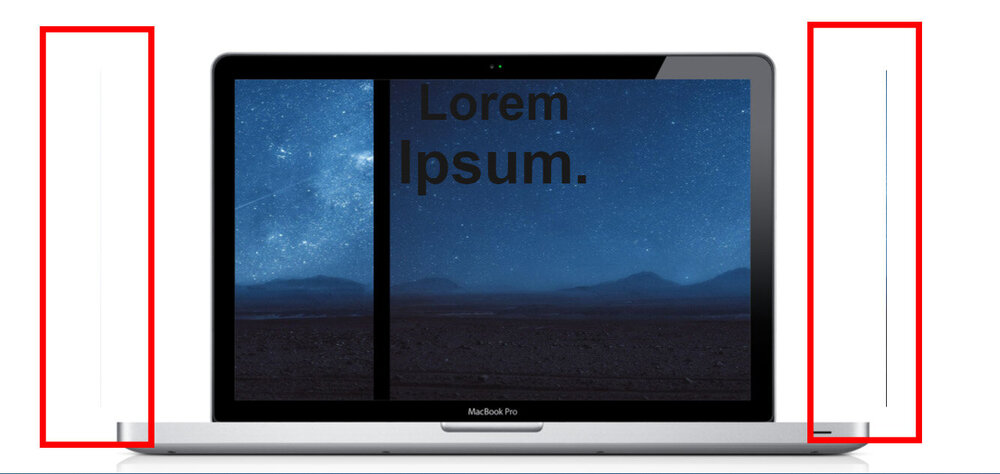

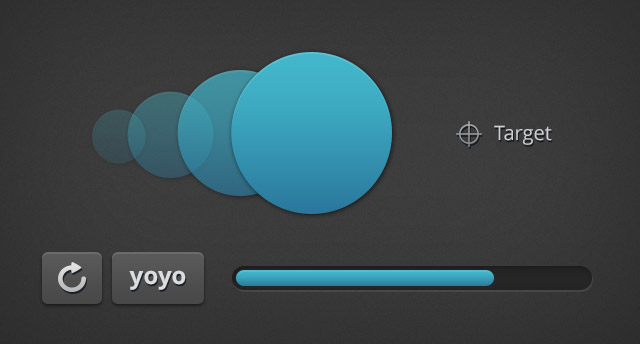

.thumb.png.9df752d5ae63a26da955184b092652fa.png)


